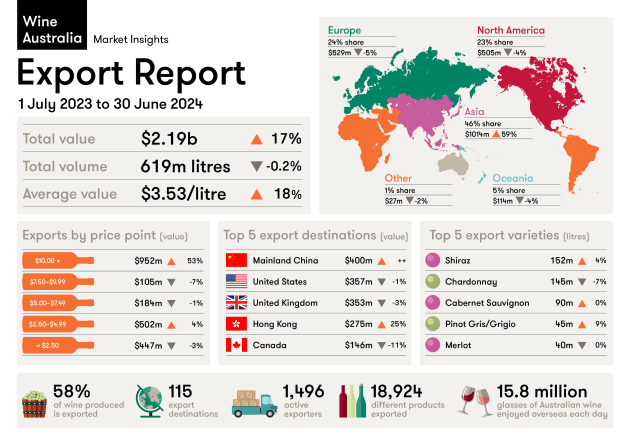Wine Australia has released its annual Export Report, which shows that in 2023-24, Australian wine exports increased in value by 17 per cent to $2.2 billion. This represents the surge in exports to mainland China, following the lifting of previously imposed tariffs, and may not reflect a future of growth.
Wine Australia is the government statutory corporation that promotes and regulates the Australian wine industry, and often collates and releases relevant data for the industry. Earlier this month, the organisation released its 2024 National Vintage Report, which showed the Australian winegrape crush had a 9 per cent year-on-year increase, but was still falling well below the 10-year average.
This year’s Export Report showed a relatively steady volume of 619 million litres, with growth largely due a surge in exports to mainland China in the last three months of the financial year. In late March 2024, China made the decision to remove the heavy tariffs it originally imposed on the Australian wine industry in November 2020. This came at a crucial time for the industry, as Australian wine re-stocked supply pipelines following the removal of the duties on bottles.
Wine Australia manager of market insights, Peter Bailey, said that the rise in exports to mainland China is still a small fraction of the historical peaks achieved to the market.
“The surge in exports to mainland China towards the end of the financial year saw volume rise from 1 million litres to 33 million litres and value grow by $392 million to $400 million compared to last financial year,” said Bailey.
“While the figures are very positive, they represent the re–stocking of Australian wine in the pipeline of a major market after a long absence and do not necessarily equate to retail sales. It will take some time before there is a clearer picture of how Chinese consumers are responding to the increased availability of Australian wine in-market.
“Consumption of both domestic and imported wines in mainland China is less than a third of what it was six years ago and thus it is very unlikely that Australian wine exports will return to those previous peaks in the short to medium term.”

Exports of Australian wine to mainland China
There were 574 companies exporting to mainland China in 2023–24, up from 115 in 2022–23. Prior to the imposition of duties, there had been over 2000.
In 2023–24, the top ten exporters by value to the market accounted for three-quarters of the total value and 39 per cent of the volume of exports. Wines priced at $20 or more per litre FOB were the main driver of the value growth to mainland China, accounting for 84 per cent of the growth.
“The growth in value has seen mainland China return to the top export market by value. However, the volume of exports at 33 million litres, is relatively small, equating to less than five per cent of Australia’s winegrape harvest in 2024 and so is unlikely to make a significant impact on the current oversupply of red winegrapes, particularly in the big volume-producing warm inland regions,” said Bailey.
Exports to the rest of the world (excluding mainland China) declined by 4 per cent ($68 million) to $1.8 billion, and volume decreased by 5 per cent (33 million litres), to 587 million litres. This is the lowest volume exported to the rest of the world in a financial year since 2003–04. The decline in volume was most significant in unpackaged exports priced under $1.50 per litre to the United States (US) and Canada, which were down by a combined 20 million litres.
“Global trading conditions remain very challenging with wine consumption continuing to fall in many markets around the world due to moderation trends and cost of living pressures. There are also enduring problems in shipping, with a shortage of ships globally and freight and charter rates on the rise,” said Bailey.
Australia is not the only country negatively impacted by these factors. Wine exports have also declined from other major wine producing countries. The volume of wine exported from Spain fell by 2 per cent, France by 7 per cent, Chile by 7 per cent, South Africa by 12 per cent, Germany by 5 per cent and New Zealand by 14 per cent.
Among varieties exported from Australia, red wine was the main beneficiary of the growth in exports to mainland China – with total volume of red wine up 3 per cent to 330 million litres and value up 27 per cent to $1.5 billion compared to 2022–23.
Cabernet Sauvignon grew in value by 41 per cent to $469 million, and volume by 12 per cent to 70 million litres, with the US also contributing to the increase in exports of this variety.
For white wine, Chardonnay remained the number one variety, and while volumes declined by 6 per cent to 158 million litres, value was up marginally to $307 million. The top performer for still white wine was Pinot Gris/Grigio, up 15 per cent in volume to 51 million litres and 16 per cent in value to $101 million, a record financial year result for the variety. The US was the main driver of the growth in Pinot Gris/Grigio exports.
The top five destinations by value were:
- Mainland China (up $392 million to $400 million)
- US (down $2 million to $357 million)
- UK (down $11 million to $353 million)
- Hong Kong (up $55 million to $275 million), and
- Canada (down $17 million to $146 million)
The top five destinations by volume were:
- UK (down 3 million litres to 217 million litres)
- US (down 11 million litres to 124 million litres)
- Canada (down 8 million litres to 68 million litres)
- Mainland China (up 31 million litres to 33 million litres), and
- New Zealand (down 3 million litres to 28 million litres).
For more information, head to Wine Australia’s Export Report and Wine Australia’s Export Dashboard.






